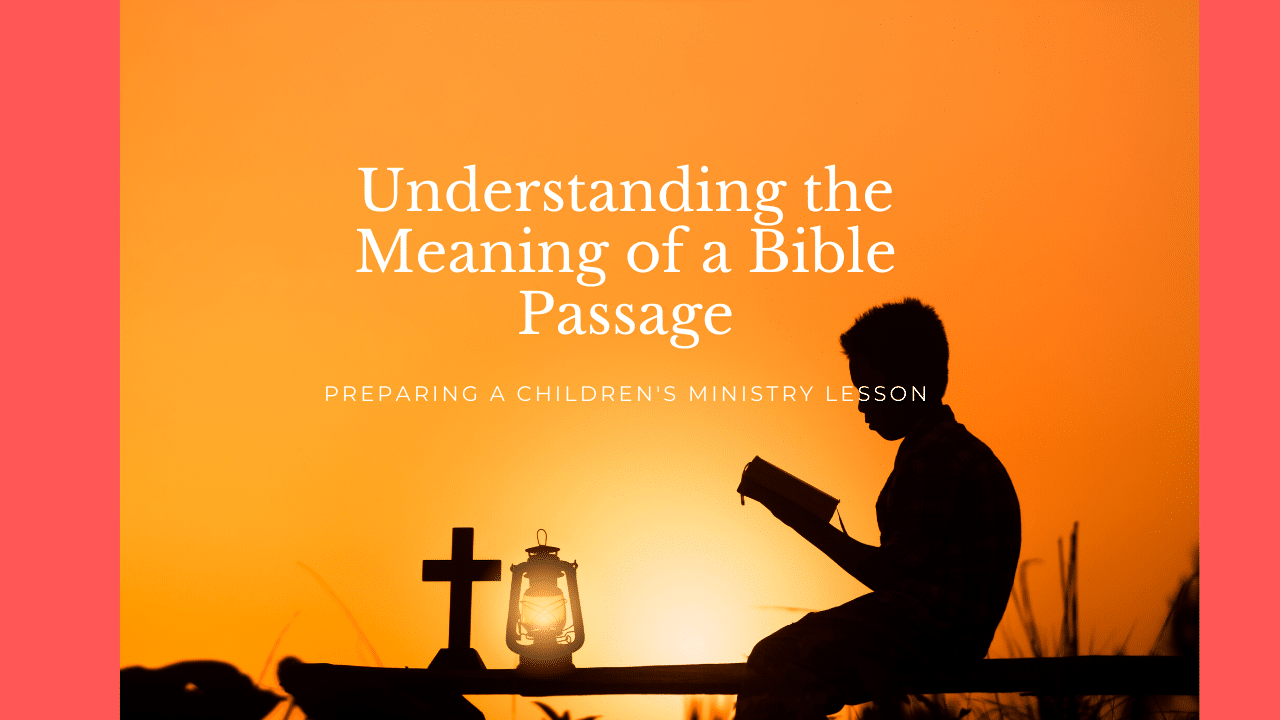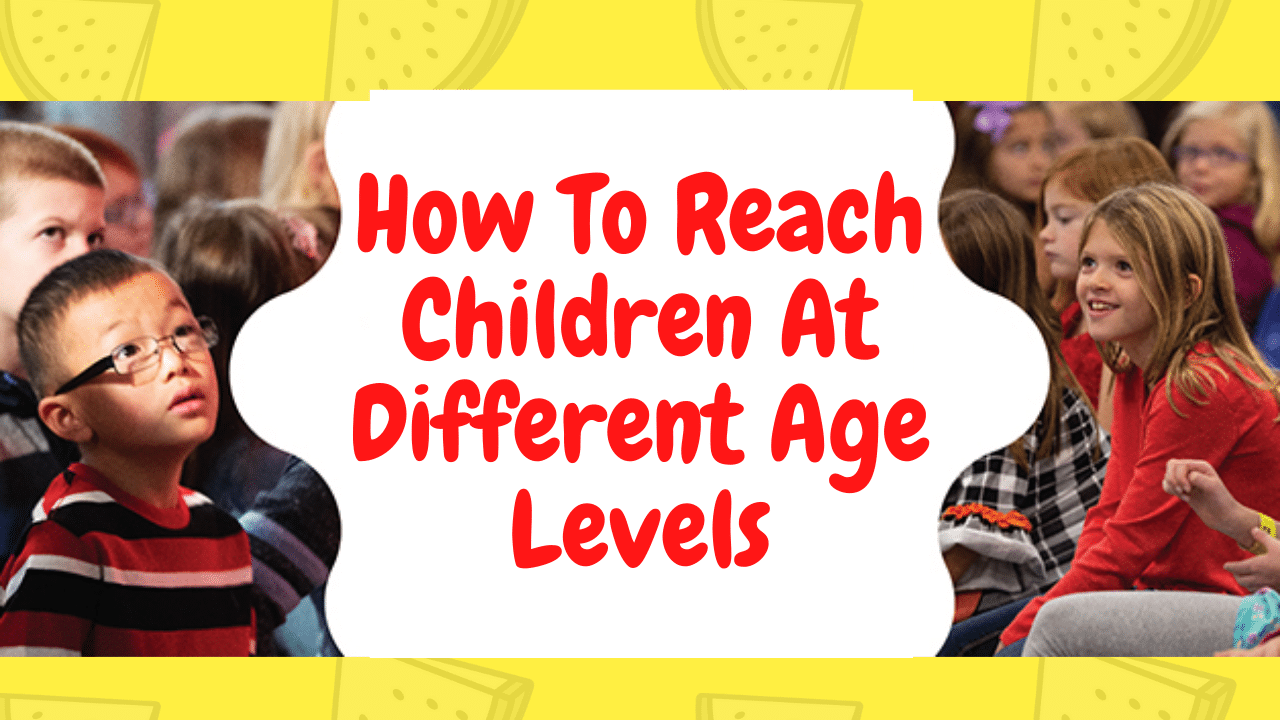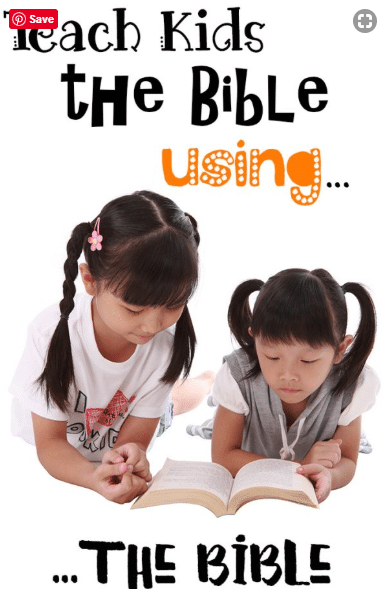Understanding the meaning of a Bible passage is a crucial stage in preparing a Bible talk to children.
In order to teach the Bible, rather than just tell the children some great stories, we need to also help them gain knowledge of what happened, what it means and how that applies to our lives today.
We call that knowledge, meaning and application.
Thisarticle is about establishing the meaning. It’s getting straight in our own heads what the meaning of the passage- what it is teaching us.
That’s important, not just for the difficult to understand bits- like when the pack of teenagers in 2 Kings 2, who mocked the prophet Elisha, were mauled to death by a couple of bears. Or the one about the talking donkey in Numbers 22.
It’s crucial for any passage we’re looking at to ensure that we’re teaching the meaning that God intends the children to learn.
The meaning is about what the passage teaches us about God or Jesus or the work of the Holy Spirit or us or the world around us or the church etc. but we need to be careful… If we start to think that it’s teaching us something that clashes with the rest of the Bible then we’ve gone wrong somewhere and we need to look at the passage again.
Here are 3 questions to help us be sure we’ve understood a passage properly.
1. How does this passage fit into the Bible’s whole story?
The Bible is one big story of God’s plan of reconciling his creation, infected and damaged by sin, back to himself. The crucial events in that are the Fall in Genesis 3, the death and resurrection of Jesus and Jesus’ future return as Judge and King.
We live between the last two…almost all of the Old Testament is between the first two. And God has been outworking his plan since before the first one til after the last one!
So, how does our passage fit into the Bible’s whole story, into what God is doing throughout history? All those Old testament narrative passages about Noah, Abraham, Moses, David, Elijah etc are all part of God’s mammoth plan to send Jesus – the Way, the Truth and the Life.
So…imagine you’re due to teach about the giving of the law at Mount Sinai in Exodus 19. God gives them the 10 Commandments and a great long set of rules.
Considering the meaning on its own it looks like the God is saying, “Obey my rules and I’ll accept you.” Is that true?
Well, Paul makes it clear in Galatians 2: 16 that “a man is not justified by the works of the law, but by the faith of Jesus Christ, even we have believed in Jesus Christ”
So maybe Old Testament people were accepted by God by obeying those rules but that it’s different in the New Testament – that it all changed with Jesus? But no, that’s pretty inconsistent of God, isn’t it?
When Jesus is asked about the Old Testament, He says in Matthew 5:17, “Think not that I am come to destroy the law, or the prophets: I am not come to destroy, but to fulfil.”
This is where asking ‘how does this fit into the whole Bible story?’ is important.
God had promised to Abraham hundreds of years previously that he would put this nation in His place under His rule as King. And one day he would bring a savior for every nation from those people- Jesus.
But to get them to God’s place God had to rescue the Israelites from Egypt. And then at Sinai He showed them how to obey and live for him. He rescued them in order for them to live as his obedient rescued, holy people, to be under His rule, to obey.
In that order! And that is consistent with the New Testament – God rescues us through the cross and then our response is to obey and live for Him.
So, to understanding the meaning of a bible passage- first ask ‘How does this fit into the Bible’s whole story?’
2. What type of writing is it?
Is it an historical account? Poetry? Prophecy? A letter? A parable?
If it’s an historical account then we need to treat the choice of language differently to a piece of figurative poetry. If it’s prophecy or a new testament letter then we need to understand what it meant to the hearers at the time and if it’s a parable then who is Jesus talking to, and why.
So, for example, when we read Revelation 1: 12-16 there’s a picture of the risen Lord Jesus, describing Him as having ‘eyes like blazing fire’, ‘feet like bronze glowing in a furnace’, a ‘voice like the sound of rushing waters’, and ‘out of his mouth came a sharp double-edged sword.’
Is this to be taken literally, like a movie clip? Well, reading the whole of Revelation shows that much of it is poetic and figurative. And we need to read this as figurative.
It might be that when we meet Jesus he’ll have a sword sticking out of his mouth. But it’s much more likely that Jesus’ words are like a sword – judging the thoughts and attitudes of the heart, as Hebrews 4:12 says “For the word of God is quick, and powerful, and sharper than any twoedged sword, piercing even to the dividing asunder of soul and spirit, and of the joints and marrow, and is a discerner of the thoughts and intents of the heart.”
3. How does the passage fit into its immediate context – the verses and chapters before and after?
So we look backwards at what has just happened or been said, and we look forwards to see what follows after. And who was listening at the time- this can be very helpful to establish. It helps us see how it may, or may not apply to us now.
Was it the Israelites? A church of Christians? Was it a mixed audience of believers and non-believers? Was it Jesus’ disciples? An individual?
And what were the circumstances?
Here’s a very child-friendly example – the parable about the Lost Sheep in Luke 15. You know the one – man with a hundred sheep, one wanders off; he looks high and low and until he finds it and then parties when he does.

And Jesus, commenting on his own story, says that there will be more rejoicing in heaven over one sinner who repents than over 99 righteous persons who do not need to repent.
Does Jesus mean that only one per cent of people need to repent? Does he mean that someone who goes off the rails is more important to God than those who stay faithful to Him? Or something else…
Considering the context here means looking backwards and forwards in Luke’s gospel and asking who is listening at the time. And there are clues to find.
If we go back we find that Luke starts this section with chapter 15:1-2 that says “Then drew near unto him all the publicans and sinners for to hear him.2 And the Pharisees and scribes murmured, saying, This man receiveth sinners, and eateth with them.”
So, there’s the big clue. Jesus is responding to the attitude and thinking of the Pharisees. And if we read on we find that Jesus adds two more similar parables. The ones about the lost coin and the lost son.
In that one the younger son messes up, realizes he’s in a desperate situation, thinks the best he can hope for is slavery and returns home where his Father lavishes love and forgiveness on him.
Meanwhile the older son has been a good son but he really doesn’t ‘get’ his father’s grace and forgiveness. In fact he thinks his father owes him something because he’s been so good.
So, the point is that Jesus is challenging the Pharisees – saying ‘Don’t be self righteous- seeing yourself as super holy’ rather see yourself as lost sinners for whom God sent his Son to die to ‘find’ i.e. rescue
To help you understand the meaning of a bible passage those are 3 questions to ask:
- How does this fit into the Bible’s whole story?
- What type of writing it is?
- How does the passage fit into its context?
Chatting it through with others and using good commentaries can also be extremely helpful but start with just you and the bible- then use others to help with the bits that you’re not sure about.
Once you are clear on what a passage means then having already worked on giving a basic knowledge of what happens in the passage, it’s relatively simple to link to how that applies to us today.
















